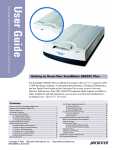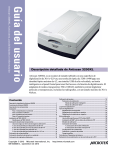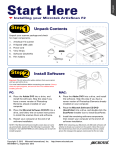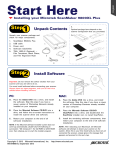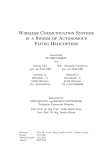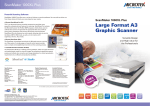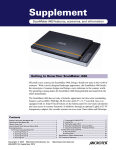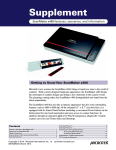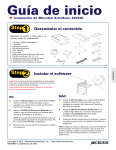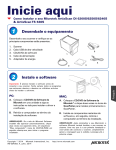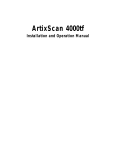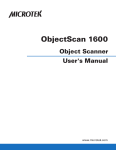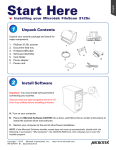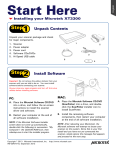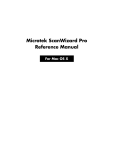Download User Guide
Transcript
User Guide ArtixScan 3200XL features, scenarios, and information Getting to Know Your ArtixScan 3200XL The ArtixScan 3200XL is a tabloid-size scanner with a 12" x 16.9" scan bed, 3200 x 6400-dpi optical resolution, 4.2 maximum optical density, a Hi-Speed USB interface, and one Smart-Touch button on the front panel for an easy access to the scan function. With the use of the TMA 1600-III Transparent Media Adapter, you can also scan film and transparencies – including X-rays – up to 12" x 16 1/16" in size. Contents Getting to KnowYour ArtixScan 3200XL ........................................................ 1 Features of the ArtixScan 3200XL ................................................................... 2 Taking a Closer Look ........................................................................................ 3 Initial Setup ...................................................................................................... 4 Step 1: Unpacking Package Contents ................................................... 4 Step 2: Installing the Software .............................................................. 5 Step 3: Unlocking the Scanner .............................................................. 6 Step 4: Connecting the Scanner ............................................................ 7 Installing theTMA 1600-III ............................................................................... 8 Unlocking theTMA 1600-III ..................................................................... 9 Positioning Transparent Film ........................................................................ 10 Using the U-Shaped Ruler (Calibration Ruler) ..................................... 11 A. Using the 35mm SlideTemplate ...................................................... 12 B. Using the 35mm Filmstrip Template ................................................ 13 C. Using the 120 FilmTemplate ............................................................. 14 D. Using the 4" x 5" FilmTemplate ........................................................ 15 Positioning Multiple Templates .................................................................... 16 Positioning Non-Standard-Size Film ........................................................... 17 Positioning Reflective Originals .................................................................... 18 Copyright © 2013 Microtek International, Inc. I49-004648 D, September 2013 Calibrating Your Scanner .............................................................................. 19 Calibration Settings .............................................................................. 21 Smart Calibration Mode ............................................................... 21 Typical Calibration Mode .............................................................. 21 Your First Scan ............................................................................................... 22 Scanning Scenarios ....................................................................................... 26 Scanning Photos ................................................................................... 26 Scanning Positive Film ......................................................................... 30 Scanning Negative Film ........................................................................ 33 Calibration Kit ................................................................................................ 36 Using the Microtek Scanner ICC Profiler (MSP) ................................. 36 MSP Installation .................................................................................... 36 Calibration Target .................................................................................. 36 Positioning the Target ........................................................................... 37 A. Positioning the ReflectiveTarget ............................................. 37 B. Positioning the Transparent Target .......................................... 37 Calibration Setup ................................................................................... 38 Calibration and Profiling ....................................................................... 39 Loading a Profile ................................................................................... 40 Specifications / System Requirements ........................................................ 41 FCC Compliance Statement .......................................................................... 42 http://www.microtek.com Features of the ArtixScan 3200XL The ArtixScan 3200XL comes with several important features, including the following: 2 • Large 12" x 16.9" scan bed: The tabloid-size scan bed of the ArtixScan 3200XL lets you easily scan oversized originals, contact sheets, large pieces of art, mechanical blueprints, and X-rays. • 3200 x 6400-dpi resolution: The exceptionally high resolution of the ArtixScan 3200XL lets you scan even postage-size images and enlarge them with amazing clarity, with little loss of detail. The scanner's 4.2 maximum optical density allows it to capture a wide range of tones approximating real-life color and hues. • Smart-Touch button: A Smart-Touch button (Scan) locating at the front panel of the scanner provides you a quick and easy way to capture images that can be automatically saved as files or sent to another application for further processing later. • Energy-saving LED light source: Adopting LEDs as the light source, when the scanner is detected by the system, there are no requirements for any warm-up time before carrying out the scan, which boots your productivity and reduces energy costs amazingly. With its stable performance, the image quality will remain consistent even after used for a certain period of time. • Microtek's ColoRescueTM system: With ColoRescue, the ArtixScan 3200XL restores faded colors in photos and film, bringing hues back to their original luster and brilliance for more vibrant images. ColoRescue's one-click, automatic color recovery process is simple and straightforward, involving no learning curve or hassle. • Transparent Media Adapter: With the use of the TMA 1600-III, you can scan Xrays, positive transparencies, and negative film. The included templates accommodate a variety of film sizes, including 35mm slides, 35mm filmstrips, 4" x 5" film, and medium format film from 6 x 4.5-cm up to 6 x 17-cm panoramic film. • Microtek ScanWizard™ Pro scanning software: This is an advanced scanner controller program that provides many powerful, professional-level features for scanning. ScanWizard Pro features two color spaces, allowing users to work in the Native CMYK / RGB mode, as well as in the intuitive LCH (Lightness, Chroma, Hue) mode. ArtixScan 3200XL User Guide Taking a Closer Look TMA 1600-III Scanner Glass surface (Scan bed) Vertical ruler READY indicator (Green) POWER indicator (Orange) Smart-Touch button (Scan) Accessory port (or with TMA 1600-III's connector securely connected) Power connector Power switch Hi-Speed USB port (1) ArtixScan 3200XL User Guide 3 Initial Setup Step 1: Unpacking Package Contents After unpacking your scanner package, please check for the major components listed below. 8 5 1 9 6 2 10 4 3 7 11 ArtixScan 3200XL (lower base) USB Cable Power Cord Software CDs/DVDs TMA 1600-III Black Plate - for scanning reflective media U-shaped Ruler (Calibration Ruler) - for calibrating your scanner or scanning film with using templates 4" x 5" Film Template (2) 120 Film Template with Black Plate (3) 35mm Slide Template (3) 35mm Filmstrip Template (3) 4 ArtixScan 3200XL User Guide Step 2: Installing the Software Important: Do not remove the yellow stickers from your scanner until you are told to do so. You must install all software before connecting your scanner. Always close any open programs and turn off Anti-virus utilities before installing software. PC: 1. Place the Adobe DVD into a driver, and install the software. Skip this step if you have a newer version of Adobe Photoshop Elements already installed on your computer. 2. Place the Microtek Software CD/DVD into a drive, and follow the on-screen instructions to install the driver and software. Note: If the Microtek Software Installer screen does not come up automatically, double-click the following in succession: “My Computer”; the DVD-ROM icon; then cdsetup.exe to start the installer program. 3. Restart your computer at the end of all software installation. MAC: 1. Place the Adobe DVD into a drive, and install the software. Skip this step if you have a newer version of Adobe Photoshop Elements already installed on your computer. 2. Place the Microtek Software CD/DVD into a drive, and double-click the ScanWizard Pro installer icon to install ScanWizard Pro first. 3. Install the remaining software components, then restart your computer at the end of all software installation. Note: After rebooting your Macintosh, the Microtek software will attempt to locate your scanner on the system. Since this is your first install and you have not yet connected the scanner, simply ignore the message that appears and proceed to the next step. Drivers & Software Upgrades After you finish the installation of software, if you found that the installed drivers and software cannot run your product or your computer system properly later, please go to the Microtek Download Service site at ww7.microtek.com.tw/service.php to download and install any updates you may require. For additional information about Microtek products, please visit our website at www.microtek.com. ArtixScan 3200XL User Guide 5 Step 3: Unlocking the Scanner Before you can operate the scanner, you will need to unlock the scanner. To unlock the scanner, follow the steps below: 1. Remove the yellow “Step 3” sticker from your scanner. 2. Look for the unlocking screw at the bottom of the scanner. 3. Using a screwdriver, push and turn the locking screw counterclockwise to the unlock position. When successfully unlocked, the screw will push out a little, protruding slightly from the bottom of the scanner. Shipping the Scanner If you have to transport the scanner, you will need to lock the scanner back. Follow the steps below: 1. Turn off the scanner. 2. Turn the scanner back on. When the indicators on the front of your scanner stop blinking, use a screwdriver, and then push and turn the locking screw clockwise to the locked position. When the screw has been tightened, this indicates that your scanner is locked. 3. Turn off your scanner. 6 ArtixScan 3200XL User Guide Step 4: Connecting the Scanner To the scanner lid Make sure the scanner lid (TMA) is properly installed, with its connector securely connected to the scanner’s 15-pin accessory port. Refer to the next section “Installing the TMA 1600-III” for the details about the connection of the TMA. To the power adapter 1. Remove the yellow “Step 4” sticker from your scanner. 2. Connect the power cord to the back of the scanner. 3. Plug the power cord into a power source. To the Hi-Speed USB cable 4. Connect one end of the cable to your computer. 5. Connect the other end of the cable to the scanner. 6. Press the power switch at the back of your scanner, and wait for the orange indicator light on the front panel to stop blinking and the green indicator light stay on steady. The system will detect your scanner automatically. ArtixScan 3200XL User Guide 7 Installing the TMA 1600-III Before starting your first scan, you have to install the TMA 1600-III first on your scanner. To install your TMA 1600-III, follow the steps below: 1. Check to make sure that the scanner power is switched off. 2. Attach the TMA 1600-III by sliding the posts at the rear of the TMA 1600-III into the holes. TMA 1600-III 3. Plug the connector of the TMA 1600III into the scanner’s 15-pin accessory port. 8 ArtixScan 3200XL User Guide Unlocking the TMA 1600-III. To unlock the TMA 1600-III, follow the steps below: 1. Remove the yellow “Step 3” sticker from the TMA 1600-III. 2. Look for the locking knob at the base of the TMA 1600-III. 3. Turn the locking knob counterclockwise to the unlock position “ ”. Shipping the TMA 1600-III If you have to transport the TMA 1600-III, you will need to lock the TMA 1600-III back. Follow the steps below: 1. Make sure the TMA 1600-III is connected to the scanner, then turn off the scanner if your scanner is on. 2. Turn the scanner back on. The TMA 1600-III's carriage will move to the standby position in a few moments. 3. When the indicators on the front of your TMA 1600-III and scanner stop blinking, turn the locking knob clockwise to the lock position “ ”. 4. Turn off your scanner and disconnect the TMA 1600-III connector from the scanner. The TMA 1600-III is ready for transport. ArtixScan 3200XL User Guide 9 Positioning Transparent Film To scan transparent film, use the templates and U-shaped Ruler (Calibration Ruler ) included with your scanner package. There are four types of templates – 35mm Slide Template, 35mm Filmstrip Template, 120 Film Template, and 4" x 5" Film Template. Use the template that correctly matches the film type to be scanned. The use of the individual film template is explained in the succeeding pages of the manual. The Black Plate Light from the TMA 1600-III and other ambient light during scanning may result in overexposed images. The Black Plate is designed to work with 120 film and reflective originals. To ensure correct exposure and optimal image quality during scanning, the Black Mat should be used to shield unwanted light out. Two kinds of Black Plates are available with your scanner package. Take note of the following before using the Black Plate. 1. The Black Plate may become dirty over time and with prolonged use. To clean the plate, use a white cotton cloth dipped in some water, and gently wipe the plate surface. This ensures that the Black Plate is in optimal condition at all times. 2. A protective film covers the Black Plate during shipping and prevents it from being scratched. When peeling the film from the plate, be careful not to tear or bend the Black Plate. 10 ArtixScan 3200XL User Guide Using the U-shaped Ruler (Calibration Ruler) The U-shaped Ruler (Calibration Ruler) is designed to work with the film template. When scanning a film, it is helpful to position the film properly. Before placing the template on the scanner glass surface, make sure first that the U-shaped Ruler has been put on the scanner glass surface. To place the U-shaped Ruler, follow the steps below: 1. Find out two Alignment Reference Marks (“ ”) and holes locating on the both sides of the scanner's upper front surface. Holes Alignment Reference Marks 2. Using the Alignment Reference Marks as a point of reference to place the U-shaped Ruler, insert the tabs at the back of the ruler into the holes on the both sides of the scanner's upper front surface, making sure that it has been oriented correctly. ArtixScan 3200XL User Guide 11 A. Using the 35mm Slide Template To scan 35mm slides, use the 35mm Slide Template, which can hold up to 4 mounted 35mm slides at a time. 1. Place the 35mm Slide Template on the scanner glass surface. Make sure to orient the template with the “Microtek” logo facing up. Calibration strip Microtek logo U-shaped Ruler (Calibration Ruler) The Grabber is used to remove the template out of the scanner glass surface. Important: Align the template's front corners firmly against the top corners (left and right) of the U-shaped Ruler located at the front of the scanner. During placement of the template, make sure that the calibration strip on the scanner glass surface is kept clear and free of obstruction at all times. 2 Place the 35mm slides to be scanned inside the individual frames of the 35mm Slide Template. The shiny base of the 35mm slide should be facing down, and the emulsion side of the slide should be facing up. Align the 35mm slide against the bottom-left corner of the frame 12 ArtixScan 3200XL User Guide B. Using the 35mm Filmstrip Template To scan 35mm filmstrips, use the 35mm Filmstrip Template, which can simultaneously hold two strips of 6 frames each, or a total of 12 frames. 1. Place the 35mm filmstrip to be scanned inside the frame of the 35mm Filmstrip Template. The shiny base of the 35mm filmstrip should be facing down, and the emulsion side of the filmstrip should be facing up. Orient template with "Microtek" logo facing up Align the edge of the film frame with the arrow mark of the template 2. Place the 35mm Filmstrip Template containing the loaded filmstrip on the scanner glass surface. Make sure to orient the template with the “Microtek” logo facing up. Calibration strip Microtek logo U-shaped Ruler (Calibration Ruler) The Grabber is used to remove the template out of the scanner glass surface. Important: Align the template's front corners firmly against the top corners (left and right) of the U-shaped Ruler located at the front of the scanner. During placement of the template, make sure that the calibration strip on the scanner glass surface is kept clear and free of obstruction at all times. ArtixScan 3200XL User Guide 13 C. Using the 120 Film Template To scan 6 x 4.5 cm, 6 x 6 cm, 6 x 7 cm, 6 x 9 cm, and 6 x 17 cm panoramic film, use the 120 Film Template, which can hold up to 4 pieces of 6 x 4.5 cm film, 2 pieces of 6 x 9 cm film, or a single piece of 6 x 17 cm panoramic film. Remove the Black Plate from the 120 Film Template before loading the 120 film 1. Place the 120 film to be scanned inside the frame of the 120 Film Template. The shiny base of the 120 film should be facing down, and the emulsion side of the film should be facing up. Orient template with "Microtek" logo facing up Align the edge of the film frame with the arrow mark of the template 2. Load the Black Plate into the template frame, with the side of the Black Plate that reads “This side up” facing up. Slide the Black Plate until its edge is against the film and completely covers the blank spaces of the template. 3. Place the 120 Film Template containing the loaded film on the scanner glass surface. Make sure to orient the template with the “Microtek” logo facing up. Calibration strip Microtek logo U-shaped Ruler (Calibration Ruler) 14 ArtixScan 3200XL User Guide The Grabber is used to remove the template out of the scanner glass surface. Important: Align the template's front corners firmly against the top corners (left and right) of the U-shaped Ruler located at the front of the scanner. During placement of the template, make sure that the calibration strip on the scanner glass surface is kept clear and free of obstruction at all times. D. Using the 4" x 5" Film Template To scan 4" x 5" film, use the 4" x 5" Film Template, which can hold up to 2 pieces of 4" x 5" film at a time. 1. Place the 4" x 5" film to be scanned inside the frame of the 4" x 5" Template. The shiny base of the 4" x 5" film should be facing down, and the emulsion side of the film should be facing up. Orient template with "Microtek" logo facing up 2. Place the 4" x 5" Film Template containing the loaded film on the scanner glass surface. Make sure to orient the template with the “Microtek” logo facing up. Calibration strip Microtek logo U-shaped Ruler (Calibration Ruler) The Grabber is used to remove the template out of the scanner glass surface. Important: Align the template's front corners firmly against the top corners (left and right) of the U-shaped Ruler located at the front of the scanner. During placement of the template, make sure that the calibration strip on the scanner glass surface is kept clear and free of obstruction at all times. ArtixScan 3200XL User Guide 15 Positioning Multiple Templates At least two sets of each template are included in your scanner package for multiple placements of the templates on the scanner. The templates can be placed side by side on the scanner glass surface, as shown in the illustration below. U-shaped Ruler (Calibration Ruler) 16 ArtixScan 3200XL User Guide Positioning Non-Standard-Size Film When scanning non-standard-size transparent film, such as 8" x 10" film, medical or dental X-ray film, you can choose either to use or not to use the U-shaped Ruler (Calibration Ruler) together with the film. The supported film size is up to 12" x 16.9". 1. Optional: Follow the procedures in “Using the U-shaped Ruler (Calibration Ruler)” to put the U-shaped Ruler on the scanner glass surface first. 2. Place the film (X-ray or other nonstandard size) to be scanned on the scanner glass surface. U-shaped Ruler (Calibration Ruler) Calibration strip To scan with the U-shaped Ruler, place the film face down on the scanner glass surface and center the film along the U-shaped Ruler on the scanner. To scan without the U-shaped Ruler, use the red arrows printed on the vertical rulers of both sides of the scanner as an alignment guide to place the film. Then, place the film on the scanner glass surface. During placement of the film, make sure that the calibration strip on the scanner glass surface is kept clear and free of obstruction at all times. Please note that the U-shaped Ruler should be removed from the glass surface of the scanner if the width of the film is larger than the width of the U-shaped Ruler. Calibration strip If the U-shaped Ruler is not going to be used, use the red arrows printed on the vertical rulers of both sides of the scanner as an alignment guide to place the film. Then, place the film on the scanner glass surface. During placement of the film, make sure that the calibration strip on the scanner glass surface is kept clear and free of obstruction at all times. ArtixScan 3200XL User Guide 17 Positioning Reflective Originals To scan reflective originals such as photos, you can use the ArtixScan 3200XL with the TMA 1600-III, you will need to use the Black Plate included in the scanner package to shield unwanted light. 1. Refer to the steps mentioned above to place the reflective original on the scanner glass surface. Calibration strip During placement of the reflective original, make sure that the calibration strip on the scanner glass surface is kept clear and free of obstruction at all times. 2. Peel the protective film from the Black Plate. 3. Put the Black Plate on top of the reflective photo to be scanned, so that the Plate covers the photo. The side of the Black Plate that reads “This side up” should be facing up. 4. Lower the TMA 1600-III down onto the scanner glass surface gently. 18 ArtixScan 3200XL User Guide Calibration strip Calibrating Your Scanner When you launch the ScanWizard Pro for the first time, you need to calibrate your scanner. Remember, in order to ensure that your scanner will work properly and provide accurate image results, the scanner calibration is a MUST procedure when setting up your scanner. To calibrate your scanner, follow the steps below: 1. Double-click the ScanWizard Pro icon on your desktop to launch the ScanWizard Pro. 2. If this is your first time to launch the ScanWizard Pro, you will be prompted to perform a calibration for your scanner. A Complete Calibration window appears. 3. In order to calibrate your scanner successfully, make sure that you have met all the conditions mentioned in the window. If not, follow the steps below to set up your scanner: a) Follow the procedures in “Installing the TMA 1600-III” and “Unlocking the TMA 1600-III” sections to install your TMA 1600-III. b) Follow the procedures in “Using the U-shaped Ruler (Calibration Ruler)” section to put the U-shaped Ruler on the scanner glass surface. c) When finished, lower the TMA 1600-III down on the scanner glass surface gently. 4. Click the Calibrate button to start calibration for your scanner. During calibrating, a processing progress bar will appear on the screen, showing the running status of the scanner. 5. When the calibration is done completely, a window will appear on the screen to notify you. Now, you may use the ScanWizard Pro as usual. Click the OK button to close the calibration window. ArtixScan 3200XL User Guide 19 Note: • Before clicking the “Calibrate” button, make sure firmly that the TMA has been connected properly with your scanner, the U-shaped Ruler (Calibration Ruler) has been put on the scanner glass surface correctly, and the scanner glass surface has been kept clear. • The calibration will take you amounts of time (approx. 10 minutes). Therefore, please be patient while the scanner is calibrating. • If you update the firmware to a new version, you have to redo the scanner calibration for optimal images. Before recalibrating your scanner, the calibration data made with the U-shaped Ruler (Calibration Ruler) should be removed from your system. Using one of the following two methods to remove the calibration data: A. Switch to the folder “C:\Program Files\Microtek\ScanWizard Pro\Scanners” (where C:\ is your ScanWizard Pro location), then delete the calibration data Calidata91_ xxxxxxxxxx.dat, Calidata2191_ xxxxxxxxxx.dat or Calidata219b_ xxxxxxxxxx.dat from the folder. B. Reset all calibration data. 1) Launch ScanWizard Pro. In the Preview window, select “Calibration Settings” from the Preferences menu. 2) Set the Calibration Mode as "Smart", and then click the “Execute” button next to the “Reset All Calibration Data" to reset all calibration data. The calibration data file saved in “C:\Program Files\Microtek\ScanWizard Pro\Scanners” folder will be removed automatically. When done, launch ScanWizard Pro, you will be invited to calibrate the scanner again. Follow the on-screen instructions to calibrate your scanner. Notice to WIA Users Before using the WIA (Windows Image Acquisition) scanning driver to scan, you should put the U-shaped Ruler on the scanner glass surface, which ensures that your scanner will function properly. For more details about how to position the U-Shaped Ruler on the scanner glass surface, see the “Using the Ushaped Ruler” section in this manual. 20 ArtixScan 3200XL User Guide Calibration Settings For a better scan quality, the ArtixScan 3200XL can be set and calibrated with ScanWizard Pro based on your preferences. To activate the Calibration Settings, go to the Menu bar at the top of ScanWizard Pro and then click the Preferences menu. Click on the “Calibration Settings” command to activate the sub-menu. Smart Calibration Mode This is the default setting of the program. When this option is selected, ScanWizard Pro will memorize the calibration values generated by different scanning settings the first time when you launch the ScanWizard Pro. When you perform the next scan job, the scanner will skip the calibration step and directly execute your order. This mode enhances the scanning speed enormously. Reset All Calibration Data If you click on the Execute button in the Smart Calibration Mode, ScanWizard Pro will delete all saved calibration data; therefore, the program will need to recalibrate your scanner to memorize the calibration values before you perform a scan job. This option is useful to check the precision and quality of the scanner. Typical Calibration Mode If this option is selected, ScanWizard Pro will calibrate the scanner every time before performing a scan job. This mode takes more time, but ensures an optimal scan quality each time you scan. Please take note that when the Calibration Mode is set as Typical, the scanner will proceed directly once the calibration is finished. Therefore, you need to put the document to scan on the scan bed in advance. ArtixScan 3200XL User Guide 21 Your First Scan This section is to guide you to perform your first scan by using the ScanWizard Pro. You should familiarize yourself with the basic scanning technique before you continue further scanning scenarios described in next pages. 1. Launch ScanWizard Pro either as a standalone by clicking the program icon, or by using the File-Import or File-Acquire command from your image-editing program (such as Adobe Photoshop). Alternatively, you can start ScanWizard Pro from the Applications folder in your Mac OS X system. • If this is your first time to launch the ScanWizard Pro, you will be prompted to perform a calibration for your scanner. For details about how to calibrate your scanner, refer to the section titled “Calibrating Your Scanner” in this manual. Note: It is a must procedure and activated automatically only when the ScanWizard Pro is started up for the first time. When you follow the on-screen instructions to finish the calibration, you will not be asked to perform the calibration anymore when you scan photos or film later. • When the scanner calibration is finished, you will be prompted to perform color calibration for your scanner. (Dialog boxes below show appearance in Windows XP and Mac OS X). Allows you to specify how often you wish to be prompted to calibrate the scanner. The default setting is 14 days 22 ArtixScan 3200XL User Guide - Click the Skip button to exit the “Calibration Reminder” window. Clicking the Skip button allows you to use the factory default ICC profile for your scanner. Note: If your scanner does not include IT8 calibration targets, disregard the Calibration reminder window whenever it appears, and click the Skip button always. - Click the Calibrate button to run the Microtek Scanner ICC Profiler (MSP) program to perform color calibration and to customize the ICC profile for your scanner. After finishing with calibration, relaunch ScanWizard Pro. Note: The MSP program should be installed before you perform color calibration for your scanner. For details on how to install the MSP program and how to use it to calibrate the scanner, refer to section of the manual titled “Microtek Calibration Kit”. • Next, you will be prompted to set up color matching for your scanner. If you are not sure about what to do, simply click the OK button to accept the settings. You can always change the settings at a later time. Pertains to how your monitor displays color, relative to the RGB Destination color space Color Matching features Improves the contrast and saturation of an image Immediately updates the Preview window image when a new setting is selected. This will reflect colors consistent with the newly selected profile For more information, see the Color Matching Setup section in the ScanWizard Pro Reference Manual in the Microtek software CD. ArtixScan 3200XL User Guide 23 2. Place the photo to be scanned on the scanner glass surface. a) Raise the TMA 1600-III. b) Use the red arrows printed on the vertical rulers of both sides of the scanner as an alignment guide and then place your photo face down on the scanner glass surface, towards the front of the scanner. Calibration strip (Keep clear and unobstructed) c) Put the Black Plate on top of the photo to cover it, with the side of the Black Plate that reads “This side up” facing up. Follow the procedures on page 18 for how to position reflective originals and use the Black Plate. 3. Go to the Preview window of ScanWizard Pro, and choose Reflective from the Scan Material menu. 4. Optional: If calibration has been performed, go to the Settings window in ScanWizard Pro. Choose the profile you have just created in the Input Profile / Scanner Profile menu. 5. Click the Overview button to perform a preliminary scan of the image, which will appear in the Preview window. 6. Select the Scan Frame tool from the Toolbar in the Preview window, and choose the area to be scanned by dragging a rectangle around it. You will see a flashing frame (marquee) around the selected area. 7. Click the Prescan button to display a detailed image of area selected by the Scan Frame tool. A thumbnail of the image appears as well in the Scan Job Queue window. 8. Specify your scanning requirements in the Settings window. a) Select a desired image type. b) Select a desired resolution. c) Adjust the scan frame settings if necessary. 9. Adjust image quality if necessary, using the Advanced Image Correction (AIC) tools. 10. If the colors in your photo are faded and need restoring, check the “Automatic Color Restoration” box in the Settings window. 24 ArtixScan 3200XL User Guide 11. Click the Scan (or “Batch”) button in the Preview window or on the scanner unit to start scanning. • If ScanWizard Pro was launched from an application program, the image is then delivered to your application, where the image can be saved, printed, or edited. Note: In Mac OS X, you will be prompted to specify the file attributes for the scanned image before scanning takes place. • If ScanWizard Pro was launched in standalone mode, you will be prompted to specify the file attributes for the scanned image after the Scan or Batch button is pressed, such as entering the file name, specifying a folder name of your own, etc. When you have completed the settings, press the Done/Save button, and the scanner will automatically scan and save your image based on your settings. ArtixScan 3200XL User Guide 25 Scanning Scenarios The following pages provide various scenarios for scanning with the ArtixScan 3200XL, including the following: 26 • Scanning photos: This scenario details the steps for scanning photos. • Scanning positive film: This scenario details the steps for scanning positive film, such as 35mm mounted slides and X-rays. • Scanning negative film: This scenario details the steps for scanning negative film, such as 35mm filmstrips, 6 x 17 cm (120) panoramic film, and 4" x 5" / 6 x 9 cm film. ArtixScan 3200XL User Guide Scanning Photos 1. Raise the TMA 1600-III and place the photo to be scanned face down on the scanner glass surface, towards the front of the scanner. Then, put the Black Plate on top of the photo to cover it, with the side of the Black Plate that reads “This side up” facing up. Follow the procedures on page 18 for how to position reflective originals and use the Black Plate. 2. Launch ScanWizard Pro either as a standalone by clicking the program icon, or by using the File-Import or File-Acquire command from your image-editing program (such as Adobe Photoshop). Alternatively, you can start ScanWizard Pro from the Applications folder in your Mac OS X system. 3. Go to the Preview window of ScanWizard Pro, and choose Reflective from the Scan Material menu. 4. Optional: If calibration has been performed, go to the Settings window in ScanWizard Pro. Choose the profile you have just created in the Input Profile / Scanner Profile menu. 5. Click the Overview button to perform a preliminary scan of the image, which will appear in the Preview window. 6. Select the Scan Frame tool from the Toolbar in the Preview window, and choose the area to be scanned by dragging a rectangle around it. You will see a flashing frame (marquee) around the selected area. 7. Click the Prescan button to display a detailed image of area selected by the Scan Frame tool. A thumbnail of the image appears as well in the Scan Job Queue window. 8. Specify your scanning requirements in the Settings window. a) Select a desired image type. b) Select a desired resolution. c) Adjust the scan frame settings if necessary. 9. Adjust image quality if necessary, using the Advanced Image Correction (AIC) tools. 10. If the colors in your photo are faded and need restoring, check the “Automatic Color Restoration” box in the Settings window. ArtixScan 3200XL User Guide 27 11. Click the Scan (or “Batch”) button in the Preview window or on the scanner unit to start scanning. • If ScanWizard Pro was launched from an application program, the image is then delivered to your application, where the image can be saved, printed, or edited. Note: In Mac OS X, you will be prompted to specify the file attributes for the scanned image before scanning takes place. • 28 If ScanWizard Pro was launched in standalone mode, you will be prompted to specify the file attributes for the scanned image after the Scan or Batch button is pressed, such as entering the file name, specifying a folder name of your own, etc. When you have completed the settings, press the Done/Save button, and the scanner will automatically scan and save your image based on your settings. ArtixScan 3200XL User Guide ArtixScan 3200XL User Guide 29 Scanning Positive Film 1. Select the film you wish to scan. Follow the procedures for positioning transparent film to load the film to be scanned. 2. Launch ScanWizard Pro either as a standalone by clicking on the program icon, or by using the File-Import or File-Acquire command from your image-editing program (such as Adobe Photoshop). Alternatively, you can start ScanWizard Pro from the Applications folder in your Mac OS X system. 3. Go to the Preview window and choose Positive / Positive Film from the Scan Material menu. If this is your first time to scan transparent media, you will be prompted to perform color calibration for your scanner. A Calibration Reminder window appears. Allows you to specify how often you wish to be prompted to calibrate the scanner. The default setting is 14 days - Click the Skip button to exit the “Calibration Reminder” window. Clicking the Skip button allows you to use the factory default ICC profile for your scanner. Note: If your scanner does not include IT8 calibration targets, disregard the Calibration reminder window whenever it appears, and click the Skip button always. 30 ArtixScan 3200XL User Guide - Click the Calibrate button to run the Microtek Scanner ICC Profiler (MSP) program to perform color calibration and to customize the ICC profile for your scanner. After finishing with calibration, relaunch ScanWizard Pro. Note: The MSP program should be installed before you perform color calibration for your scanner. For details on how to install the MSP program and how to use it to calibrate the scanner, refer to section of the manual titled “Using the Microtek Scanner ICC Profiler”. 4. Optional: If calibration has been performed, go to the Settings window in ScanWizard Pro. Choose the profile you have just created in the Input Profile / Scanner Profile menu. 5. Click the Overview button to perform a preliminary scan of your original. 6. Select the Scan Frame tool from the Toolbar in the Preview window, and choose the area to be scanned by dragging a rectangle around it. You will see a flashing frame (marquee) around the selected area. 7. Click the Prescan button to display a detailed image area selected via the Scan Frame tool. A thumbnail of the image appears as well in the Scan Job Queue window. 8. Specify your scanning requirements in the Settings window. a) Select a desired image type. b) Select a desired resolution. c) Adjust the scan frame settings if necessary. 9. Adjust image quality if necessary, using the Advanced Image Correction (AIC) tools. 10. If the colors in your photo are faded and need restoring, check the “Automatic Color Restoration” box in the Settings window. 11. Click the Scan (or “Batch”) button in the Preview window or on the scanner unit to start scanning. • If ScanWizard Pro was launched from an application program, the image is then delivered to your application, where the image can be saved, printed, or edited. Note: In Mac OS X, you will be prompted to specify the file attributes for the scanned image before scanning takes place. • If ScanWizard Pro was launched in standalone mode, you will be prompted to specify the file attributes for the scanned image after the Scan or Batch button is pressed, such as entering the file name, specifying a folder name of your own, etc. When you have completed the settings, press the Done/Save button, and the scanner will automatically scan and save your image based on your settings. ArtixScan 3200XL User Guide 31 For film scanning using the template, it is normal for a blank strip to appear in the preview window after you perform a preliminary scan of your original. The New button allows you to create as many scan jobs as you wish, and each scan job can then have its own settings. For film scanning using the U-shaped Ruler (Calibration Ruler), it is normal for a black area to appear in the preview window after you perform a prescan of your original. 32 ArtixScan 3200XL User Guide Scanning Negative Film 1. Select the film you wish to scan. Follow the procedures for positioning transparent film to be scanned. 2. Launch ScanWizard Pro either as a standalone by clicking on the program icon, or by using the File-Import or File-Acquire command from your image-editing program (such as Adobe Photoshop). Alternatively, you can start ScanWizard Pro from the Applications folder in your Mac OS X system. 3. Go to the Preview window and choose Negative / Negative Film from the Scan Material menu. 4. Click the Overview button to perform a preliminary scan of your original. 5. Select the Scan Frame tool from the Toolbar in the Preview window, and choose the area to be scanned by dragging a rectangle around it. You will see a flashing frame (marquee) around the selected area. 6. Click the Prescan button to display a detailed image. A thumbnail of the image appears as well in the Scan Job Queue window. 7. In the Negative Scan Settings window, you can specify options related to your scanned negative film. Follow the steps below. a) In the Negative Scan Settings window, choose the Film Brand, Film Type, and ISO settings that match your film. b) The settings for the negative film you selected are applied to the prescan image, and the adjusted image is displayed in the Preview window. c) You can save the selected negative film settings into the Preset drop-down menu for easy access in the future. ArtixScan 3200XL User Guide 33 For more details on how to control settings for negative film scanning, see the section “Negative Scan Settings Window” in the ScanWizard Pro Reference Manual in the Microtek CD-ROM. 8. Specify your scanning requirements in the Settings window. a) Select a desired image type. b) Select a desired resolution. c) Adjust the scan frame settings if necessary. 9. Adjust image quality if necessary, using the Advanced Image Correction (AIC) tools. 10. If the colors in your film are faded and need restoring, check the “Automatic Color Restoration” box in the Settings window. 11. Click the Scan (or “Batch”) button in the Preview window or on the scanner unit to start scanning. • If ScanWizard Pro was launched from an application program, the image is then delivered to your application, where the image can be saved, printed, or edited. Note: In Mac OS X, you will be prompted to specify the file attributes for the scanned image before scanning takes place. • 34 If ScanWizard Pro was launched in standalone mode, you will be prompted to specify the file attributes for the scanned image after the Scan or Batch button is pressed, such as entering the file name, specifying a folder name of your own, etc. When you have completed the settings, press the Done/Save button, and the scanner will automatically scan and save your image based on your settings. ArtixScan 3200XL User Guide ArtixScan 3200XL User Guide 35 Calibration Kit This chapter is for the user who has the Calibration Kit either as a standard bundle or an optional accessory, depending on the scanner configuration that you purchased. The instructions about how to use the Calibration Kit will be explained in the succeeding pages in the manual. Using the Microtek Scanner ICC Profiler (MSP) The Microtek Scanner ICC Profiler (MSP) is a scanner calibration and profiling utility program designed exclusively for Microtek scanners. Used together with the color calibration target, the ICC Profiler determines the color attributes of your scanner accurately, then generates an ICC profile tailored exclusively for the scanner that you are using under ScanWizard Pro. MSP and IT8 Calibration Data Installation Before installing MSP, ScanWizard Pro needs to be installed on your system. This will ensure that the MSP utility will install and function properly. To install MSP, take note of the following: • For PC: Place the Microtek Software CD-ROM into the CD-ROM drive, then double click the MSP installer icon. Follow the on-screen instructions to install and you will be prompted to insert the IT8 Calibration Data CD included in your software kit. Insert the IT8 Calibration Data CD to ensure that the MSP utility will have the latest color profile targets to reference. Then the MSP installation is complete. • For Mac OS X: Place the Microtek Software CD-ROM into the CD-ROM drive, then double click the MSP installer icon. After installing the software, insert the IT8 Calibration Data CD and double-click the IT8 installer icon. Follow the onscreen instructions to install the IT8 Calibration Data to ensure that the MSP utility will have the latest color profile targets to reference. Then the MSP installation is complete. Calibration Targets The calibration kit for your MSP program comprises two industry-standard IT8 color targets: a Reflective target (IT8, size 10 x 15-cm ); and a Transparent target (IT8, size 6 x 7-cm). The calibration targets are very delicate and must be handled carefully. Take note of the following: • Gently remove targets from their respective protective sleeves and avoid touching the target image surface. • When not in use, keep targets in their sleeves and keep away from light and heat. 36 ArtixScan 3200XL User Guide Note: To keep the colors in your scanner consistent, you should perform color calibration on a regular basis. Professional photographers, graphic designers or others who require extremely precise color may wish to calibrate the scanner every time it is used. Positioning the Target Proper positioning of the target on the scanner is important for successful calibration. Incorrect positioning of the target will result in an unsuccessful calibration. A. Positioning the Reflective Target 1. Use the red arrows printed on the vertical rulers of both sides of the scanner as an alignment guide for positioning the target. 2. Place the target face down on the scanner glass surface, making sure that the target is positioned correct side up toward the front of the scanner. Note: To scan the target with the TMA 1600-III, put the Black Plate on top of the target to cover the target and shield unwanted light. Calibration strip Important: During placement of the target, the calibration strip on the scanner glass surface should be kept clear and free of obstruction at all times. B. Positioning the Transparent Target 1. Place the U-shaped Rule (Calibration Ruler) on the scanner glass surface. 2. Load the target face down inside the slot of the 120 Film Template. 3. Place the 120 Film Template with the loaded target on the scanner glass surface, and orient the template with the “Microtek” logo facing up. Calibration strip U-shaped Ruler (Calibration Ruler) Important: Align the template's front corners firmly against the top corners (left and right) of the U-shaped Ruler located at the front of the scanner. During placement of the template, make sure that the calibration strip on the scanner glass surface is kept clear and free of obstruction at all times. ArtixScan 3200XL User Guide 37 Calibration Setup With the target properly positioned on the scanner, turn on your scanner and let it warm up for about five minutes. Launch the MSP program; the MSP main window appears. A B C D A. Choose the scanner model that you are calibrating. B. Choose the correct target media. If you are calibrating the reflective target, select Reflective. Otherwise, select Positive. C. Select the date code and target type (or reference number) from the drop-down list that matches your target. You can verify this information by looking at the left corner of the target’s bottom margin. If the desired data file is not present in the drop-down menu, install the IT8 Calibration Data to update the target profiles in your system. D. When all the settings are done, click the Start (or Start Profiling) button. The calibration window will appear, and an initial preview of the target is performed. 38 ArtixScan 3200XL User Guide Calibration and Profiling After the Preview, you are now ready to complete calibration and create a profile for your scanner. 1. Scan the target. To do this, select the entire target by dragging a frame over it, and then click the Next>> button. 2. Align the registration marks of the target with your cursor (see inset at bottom of page). 3. Click the Create Profile button (PC) or Finish button (Mac) to create the scanner ICC profile. At the end of the profiling process, a dialog box appears, prompting you to enter a profile name and description. Aligning the Registration Marks A. Upper-left registration mark B. Upper-right registration mark C. Bottom-right registration mark Move the cursor to the target image area; the pointer will change to a horizontally flipped L mark (“ ”). Align the cursor with the small upperleft registration mark. After the upper left mark is aligned, the upper right part of the target image is displayed, and an instruction dialog box prompts you to align the upper right registration mark. Move the cursor to the target image area; the pointer will change to a normal L mark (“ ”). Align the cursor with the small upper-right registration mark. After the upper right mark is aligned, the lower right part of the target image is displayed, and an instruction dialog box prompts you to align the bottom-right registration mark. Move the cursor to the target image area; the pointer will change to a vertically flipped L mark (“ ”). Align the cursor with the small bottomright registration mark. ArtixScan 3200XL User Guide 39 Loading a Profile Once the profile has been produced, follow the steps below to load the profile you just created. 1. Launch ScanWizard Pro. 2. In the Preview window, click the Scan Material icon. Select the “Reflective” option for reflective materials; select the “Positive” or “Positive Film” option for transparencies and slides. 3. From the Settings window, click the Scanner Profile/Input Profile list box, and select the profile you have just created. 40 ArtixScan 3200XL User Guide Specifications Scanning Modes Scanning Area Resolution Dynamic Range Interface Dimensions (L x W x H) Weight Voltage Power Consumption Environment Color, grayscale, and black-and-white in a single scanning pass True 48-bit color (approx. 281 billion colors) 16-bit grayscale (approx. 65,536 shades of gray) Reflective: 12" x 16.9" (304.8 mm x 429.26 mm) Transparent: 12" x 16 1/16" (304.8 mm x 408 mm) Optical: 3200 (H) dpi x 6400 (V) dpi Reflective: 1.9 Dmax Transparent: 4.2 Dmax Hi-Speed USB (USB 2.0) 24.7" x 14.8" x 7.3" ( 627 mm x 375 mm x 185 mm) 35.4 lbs (16.1 kg) AC 100V-240V, 47-63 Hz, 1.5 A max. 54.9 W max. Operating Temperature: 50° F to 104° F (10° C to 40° C) Relative Humidity: 20% to 85% System Requirements General Requirements • DVD-ROM drive (for installing software) • Color display with 24-bit color output capability • 512 MB RAM or more PC and compatibles • Pentium IV PC or higher with Hi-Speed USB (USB 2.0) port • Microsoft Windows XP, Vista, Windows 7 or 8 Macintosh • iMac or Mac G3/G4/G5 with built-in USB port • Mac OS X 10.3.9 or later Important Specifications, software bundles, and accessories are subject to change without notice. Not responsible for typographic errors. ArtixScan 3200XL User Guide 41 FCC Compliance Statement This equipment (Model: MRS-6400A3L) has been tested and found to comply with the limits for a Class B digital device, pursuant to Part 15 of the FCC rules. These limits are designed to provide reasonable protection against harmful interference in a residential installation. This equipment generates, uses and can radiate radio frequency energy and, if not installed and used in accordance with the instructions, may cause harmful interference to radio communications. However, there is no guarantee that interference will not occur in a particular installation. If this equipment does cause harmful interference to radio or television reception, which can be determined by turning the equipment off and on, the user is encouraged to try to correct the interference by one or more of the following measures: • Reorient or relocate the receiving antenna. • Increase the separation between the equipment and receiver. • Connect the equipment into an outlet on a circuit different from that to which the receiver is connected. • Consult the dealer or an experienced radio/TV technician for help. Note: A shielded Hi-Speed USB interface cable with ferrite core installed on the scanner connector and must be used with this equipment. Caution: Changes or modifications not expressly approved by the manufacturer responsible for compliance could void the user's authority to operate the equipment. This device complies with Part 15 of the FCC Rules. Operation is subject to the following two conditions: (1) This device may not cause harmful interference, and (2) this device must accept any interference received, including interference that may cause undesired operation. 42 ArtixScan 3200XL User Guide ArtixScan 3200XL User Guide 43











































